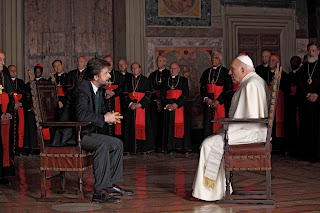John Chamberlain: Choices at the Guggenheim Museum
John Chamberlain, a revolutionary, definition-skirting sculptor who lived and worked on Shelter Island, and the Guggenheim Museum have a special relationship. For one, in 1966 and 1977 Chamberlain received a John S. Guggenheim Fellowship from the same foundation that funds the family’s numerous art museums. But the bond is more than direct connection. Chamberlain’s works seem to have been made for the blinding white walls of the turning, sloping halls of the Guggenheim, and vice versa. Each writhing medusa of scrap metal Chamberlain has molded into a non-representative visual boasts its own alcove, and each bursts from within like a flower designed to be planted just where it is. Even if not all of Chamberlain’s sculptures are perfect, or even beautiful per se, their oneness with the Guggenheim more than makes up for it.
John Chamberlain has described work on his sculptures to be similar to “handling toilet paper,” and the final product to be something akin to “bed sheets after a night of raucous sex.” Well, however you may choose to look at his work, the truth of it is that the sculptures are nothing more than what they’re made of—discarded, junkyard cars. Chamberlain takes exclusively the garbage, the dregs of societal life, and crafts them into something exclusively different and indefinable. There’s something about these explosions of chrome, and also something very familiar; most likely because in one way they are pop art from the boundaries of what pop art really means, and at the same time the purest expression of Americana. (After all, there are few things Americans love more than cars.) This is what makes them so interesting to look at, because aesthetically they don’t fall into any one category.
But as the lights reflect marvelously off their multifaceted surfaces they develop a category of their own, one Chamberlain has created for himself. My personal favorites were the arcing tubes of aluminum foil braided together and curling in unusual and somehow profound positions, balancing on one or two outcrops as the rest aim up to the Guggenheim’s majestic skylight. A good example is the colossal silver beauty in the museum entryway, which must point up four floors. However, not all of Chamberlain’s choices turn out for the better. Early on in his career came a series of compressed garbage cubes containing anchovy packets and cigarette boxes pressed into a frame-thin composition. These pale in comparison to the three-dimensional efforts of later in the ‘60’s and ‘70’s, which the open alcoves of the museum provide ample opportunity to walk all the way around and consider from all angles.
The pieces themselves aren’t the only art. To name his pieces Chamberlain often wrote unrelated words and phrases on index cards and shuffled them, using the often humorous results to name his pieces. Often they have little to do with what the work looks like or even means (which, Chamberlain has tried to emphasize, is always nothing, just expressionism), but they are entertaining, and they contribute to Chamberlain’s artsy and mysterious persona.
Sadly, Chamberlain isn’t with us to promote that persona and wasn’t even there to view the culmination of his life’s work on display at the Guggenheim. He died of natural causes at 84 in December. However, I’m sure he’d be proud of the justice the museum did to him in setting up an exhibition as purely enjoyable as this one was, and one that showed him to be as creative and dynamic as he was. His work, though not impeccable (but is anyone’s, really?) is excellent, and it made my afternoon brighter to watch the midday sun bounce off his tinfoil and steel creations.




